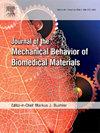利用原位 SEM 微柱压缩技术观察激光粉末床熔融钛合金(Ti-6Al-4V)的微机械特性
IF 3.3
2区 医学
Q2 ENGINEERING, BIOMEDICAL
Journal of the Mechanical Behavior of Biomedical Materials
Pub Date : 2024-11-01
DOI:10.1016/j.jmbbm.2024.106794
引用次数: 0
摘要
虽然通过激光粉末床熔融(L-PBF)制造的钛合金(Ti-6Al-4V)表现出复杂的变形行为,但其与加载方向相关的重要微观机械特性尚未得到充分了解。本研究旨在利用原位扫描电子显微镜(SEM)微柱技术研究印刷 L-PBF Ti-6Al-4V 合金在垂直(即加载方向垂直于印刷层)和水平(即加载方向平行于印刷层)压缩条件下的微观力学行为。Ti-6Al-4V 合金是采用 45° 旋转扫描策略,在垂直和水平方向上进行 L-PBF 印刷的。利用扫描电子显微镜和能量色散 X 射线光谱(EDS)分析了两种合金的微观结构。钛合金微柱是在扫描电镜中使用聚焦离子束(FIB)铣制而成的。使用平面金刚石压头对 SEM 微柱进行了原位压缩。垂直合金的α′马氏体横纹比水平合金小。虽然垂直微柱和水平微柱都表现出弹塑性行为,但前者的屈服强度、断裂强度和压缩强度值以及回弹性和韧性都明显高于后者,从而形成了有利的剪切带。两种微柱都表现出韧性断裂,但其破坏机制各不相同。垂直微柱的韧性断裂是由于应变硬化、大塑性变形和剪切带的形成,而水平微柱的韧性断裂是由于压缩引起的弯曲和塑性屈曲。L-PBF Ti-6Al-4V 材料的微机械特性为了解合金受加载方向影响的小尺度变形和破坏机理提供了重要依据。本文章由计算机程序翻译,如有差异,请以英文原文为准。
Micromechanical characteristics of titanium alloy (Ti-6Al-4V) made by laser powder bed fusion using an in-situ SEM micropillar compression technique
While titanium alloy (Ti-6Al-4V) made by laser powder bed fusion (L–PBF) exhibits complex deformation behaviors, its important micromechanical properties in relation to loading directions are not fully understood. This research aims to investigate the micromechanical behaviors of printed L–PBF Ti-6Al-4V alloys under vertical (i.e., the loading direction perpendicular to printed layers) and horizontal (i.e., the loading direction parallel to printed layers) compressions using in-situ scanning electron microscopy (SEM) micropillar techniques. Ti-6Al-4V alloys were L-PBF-printed using a 45° rotate scanning strategy with vertical and horizontal build directions. The microstructures of the two alloys were analyzed using the SEM with energy-dispersive X-ray spectroscopy (EDS). The titanium alloy micropillars were produced using focused ion beam (FIB) milling in the SEM. In-situ SEM micropillar compressions were conducted using a flat diamond indenter. Vertical alloy had smaller cross-patterned finer α′ martensite than horizontal one. While both vertical and horizontal micropillars showed elastic-plastic behaviors, the former had significantly higher yield, fracture, and compression strength values, as well as resilience and toughness, than the latter, leading to the formation of favorable shear bands. Both micropillars exhibited ductile fractures but had distinct failure mechanisms. The ductile fracture in the vertical micropillars was due to strain hardening, large plastic deformation, and shear band formation, while the ductile fracture in the horizontal ones was attributed to compression-induced bending and plastic buckling. The micromechanical characteristics of L–PBF Ti-6Al-4V materials provides an important insight into the small-scale deformation and failure mechanisms of the alloys influenced by loading directions.
求助全文
通过发布文献求助,成功后即可免费获取论文全文。
去求助
来源期刊

Journal of the Mechanical Behavior of Biomedical Materials
工程技术-材料科学:生物材料
CiteScore
7.20
自引率
7.70%
发文量
505
审稿时长
46 days
期刊介绍:
The Journal of the Mechanical Behavior of Biomedical Materials is concerned with the mechanical deformation, damage and failure under applied forces, of biological material (at the tissue, cellular and molecular levels) and of biomaterials, i.e. those materials which are designed to mimic or replace biological materials.
The primary focus of the journal is the synthesis of materials science, biology, and medical and dental science. Reports of fundamental scientific investigations are welcome, as are articles concerned with the practical application of materials in medical devices. Both experimental and theoretical work is of interest; theoretical papers will normally include comparison of predictions with experimental data, though we recognize that this may not always be appropriate. The journal also publishes technical notes concerned with emerging experimental or theoretical techniques, letters to the editor and, by invitation, review articles and papers describing existing techniques for the benefit of an interdisciplinary readership.
 求助内容:
求助内容: 应助结果提醒方式:
应助结果提醒方式:


